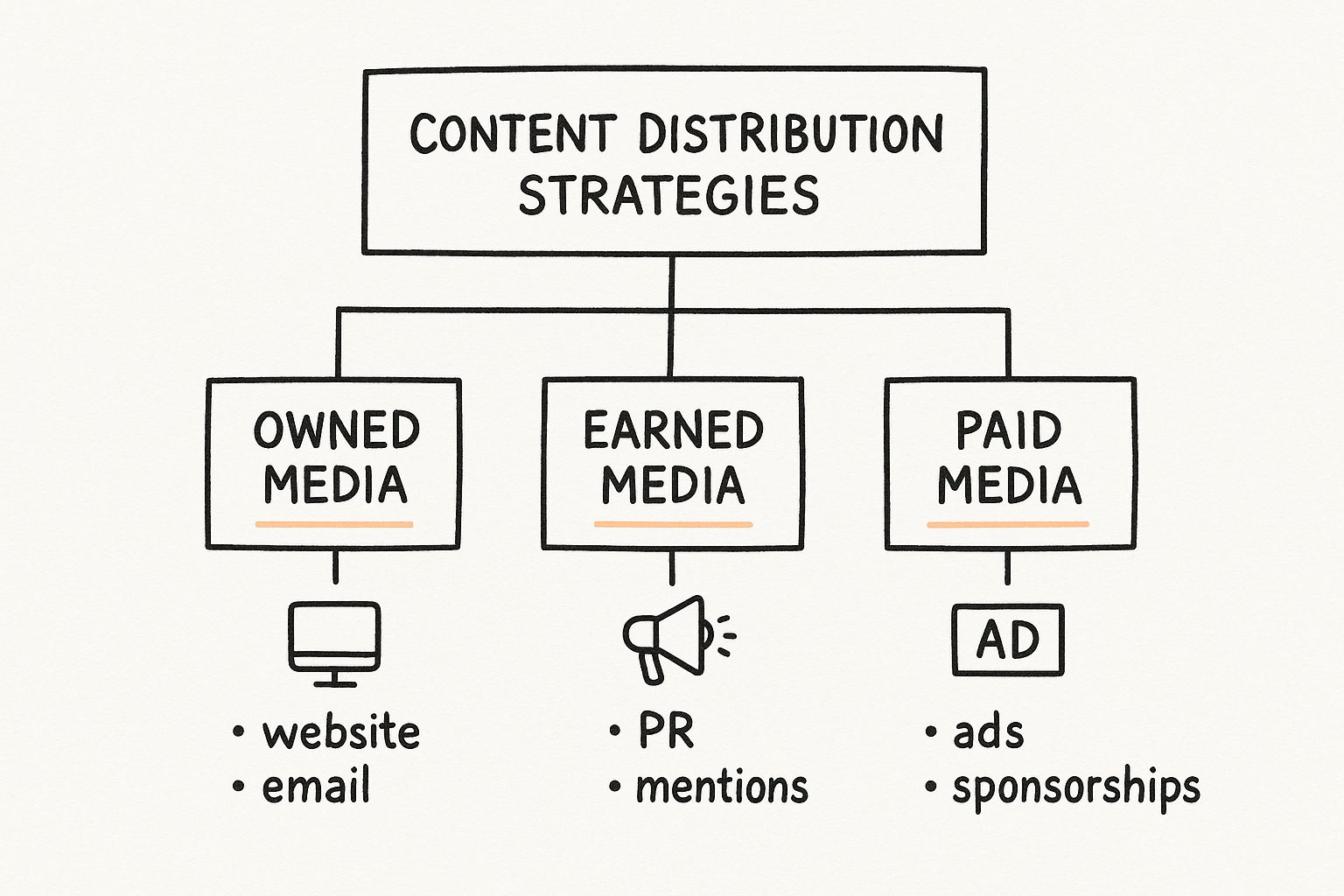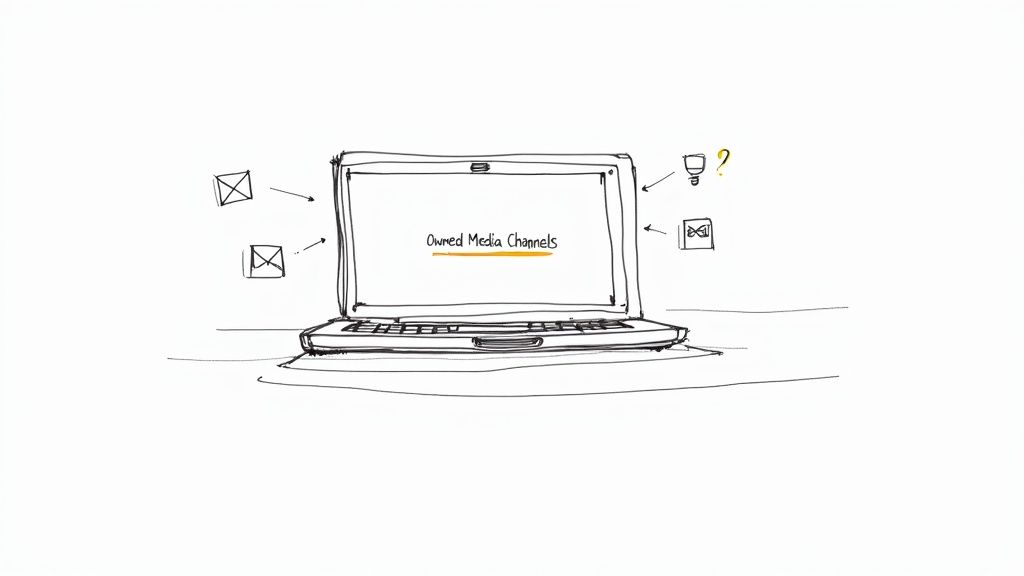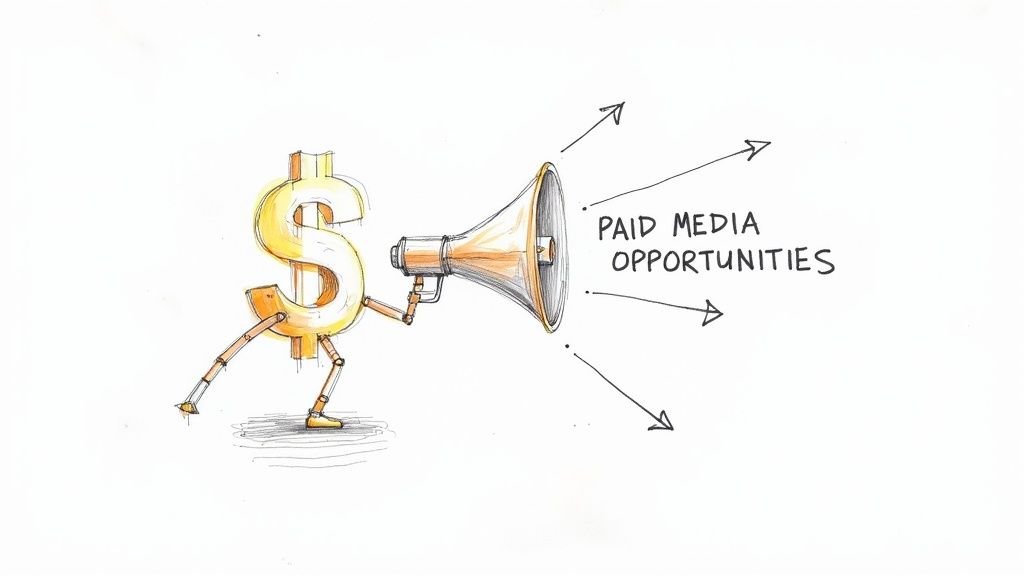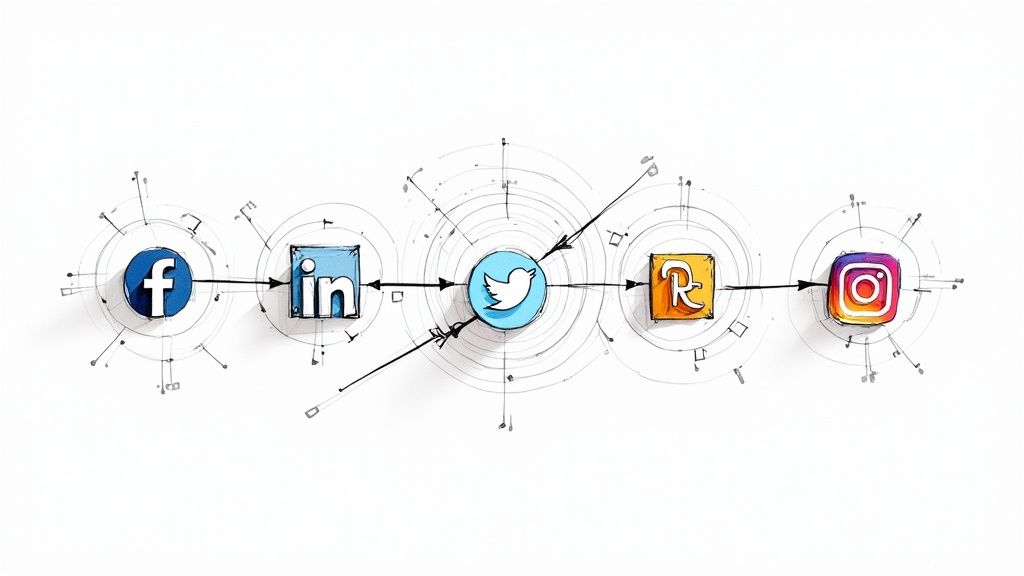Effective Content Distribution Strategies to Boost Visibility

Content distribution is simply how you get your book-related content in front of the people who will actually want to read it. Think about it this way: writing a killer blog post or a fascinating excerpt from your book is only half the battle. Leaving it sitting on your hard drive is like writing a novel and then shoving it in a desk drawer.
A smart distribution plan is the difference between writing for yourself and building an audience. It ensures all that hard work actually connects with the right readers at the right time.
What Are Content Distribution Strategies
Imagine you've built a fantastic bridge—that's your content. It's well-crafted, strong, and leads somewhere interesting. But a bridge is useless if no roads lead to it. Content distribution is the process of building those roads, creating clear pathways that guide potential readers straight to your work.
Without a deliberate plan, even the most brilliant content gets lost in the noise of the internet. A solid framework moves you from just making stuff to strategically delivering it where it will make an impact. For authors trying to stand out, this isn't optional. The goal isn't to shout into the void but to join conversations happening on platforms your target audience already knows and loves.
The Core Distribution Models
To make sense of it all, it helps to think of distribution in terms of four main channels. Each one has its own strengths, and the most successful authors learn to blend them together for maximum effect. This approach helps you balance long-term brand building with short-term visibility boosts.
Let's break down these pillars. The table below gives you a quick overview of the four core models and how they apply directly to an author's marketing efforts.
The Four Pillars of Content Distribution for Authors
| Distribution Model | Primary Characteristic | Examples for Authors |
|---|---|---|
| Owned Media | Channels you directly control. | Your author website, personal blog, and email newsletter. |
| Earned Media | Organic exposure you don't pay for. | Book reviews, podcast interviews, guest posts on other blogs, media mentions. |
| Paid Media | Paying for guaranteed placement. | Facebook ads, Amazon ads, sponsored posts, paid book promotions. |
| Social Media | Community-building platforms. | Your Instagram profile, TikTok account, Facebook author page, Twitter feed. |
As you can see, a powerful strategy doesn't rely on just one of these. It's about creating a system where they all work together. Your owned media is your home base, while earned, paid, and social channels act as megaphones to amplify your message.
The visual below helps illustrate how these channels fit together to form a cohesive promotional plan.

While your owned channels build a lasting foundation, the other channels are crucial for reaching people who haven't heard of you yet. To see how these pieces fit into the bigger picture, it’s worth exploring what a comprehensive content marketing strategy looks like from start to finish.
The most successful authors don't just write great books; they build systems to ensure those books are discovered. Your distribution strategy is that system—a repeatable process for turning content into new readers.
Building Your Author Platform on Owned Media

While social media and paid ads can give you a quick burst of visibility, your owned media channels are the true foundation of a lasting author career. Think of these as the digital properties you actually own and control—your website, your blog, and your email list. They’re your home base online, a space where you make the rules and aren't at the mercy of some algorithm's latest mood swing.
Investing in your owned platform is a long game, but it’s one that pays off in a huge way. This is where you turn casual browsers into devoted fans, building a community that will stick with you from one book launch to the next.
Your Author Website as a Content Hub
Your author website shouldn't just be a static, online business card. It needs to be a living, breathing hub for everything you create. This is your chance to let your personality shine, share behind-the-scenes glimpses into your process, and establish yourself as an authority in your genre.
The most potent tool in your website's arsenal? Your blog. A consistently updated blog is an absolute powerhouse for search engine optimization (SEO), drawing in new readers who are actively searching for topics connected to your books. By writing valuable posts—maybe a deep dive into a character's backstory, an explanation of your world-building, or an article exploring your book's themes—you create countless new doorways for people to discover you.
This isn't just a nice-to-have; it's becoming essential. The global content marketing market is expected to explode to $2 trillion by 2032, a staggering leap from $413.2 billion in 2022. That number tells you everything you need to know about how much value is being placed on creating and sharing quality content.
Subscribe & Get Your Free Marketing Plan Template
Receive regular updates on marketing best-practices, AI shortcuts, and get our proven 4-phase marketing roadmap for free.
Unsubscribe anytime.
Your blog isn't just a place for announcements. It’s a magnet for your ideal readers. Every single post is a new hook in the water, a chance for someone to find your work, fall in love with your ideas, and take the next step.
The Unrivaled Power of an Email List
If your website is your home, then your email list is your private phone line to your biggest fans. I’m not exaggerating when I say it is the single most valuable asset you can build as an author. Unlike on social media, where you’re shouting into a crowded room and hoping the algorithm lets a few people hear you, an email gives you direct, unfiltered access to your readers' inboxes.
Growing this list should be one of your top priorities. To do it right, you need to give people a compelling reason to hand over their email addresses. This is where a lead magnet comes into play.
A great lead magnet offers something of genuine value in exchange for that email. For example, you could offer:
- A free short story set in the world of your novel.
- The first few chapters of your upcoming book.
- An exclusive character guide or a map of your world.
- A helpful checklist or resource related to your non-fiction topic.
The trick is to offer something your target reader truly wants—something irresistible. That simple exchange is the start of a real relationship. Once they're on your list, you can nurture that connection with newsletters, share exclusive content, and announce new releases to an audience that's already eager to hear from you. Learning these skills is central to any serious book promotion strategy. For more great ideas, check out our guide on how to market a book.
Your website and email list are the twin engines of your content strategy. You use your site to attract people and then funnel that traffic into your email list. This creates a powerful, self-sustaining loop that builds a loyal and engaged fanbase over time.
Taking Your Story Further with Earned and Social Media
If your own channels are your home base, think of earned media as the powerful word-of-mouth that gets people buzzing about you all over town. It's what happens when someone else—a blogger, a podcaster, a reviewer—starts talking about your work simply because they think it's great.
This isn’t about buying ads; it’s about earning attention. You’re essentially moving your message from your small, personal stage to someone else's much larger one. When a respected book blogger reviews your novel, you're not just getting in front of their audience; you're borrowing their credibility. It's one of the most authentic ways to find readers who might never have stumbled upon you otherwise.
How to Get People Talking
Generating this kind of buzz doesn't happen by accident. It requires a bit of hustle and a lot of genuine connection. You need to strategically place your story and your expertise where influential people in your niche will see it.
Here are a few classic ways to generate earned media:
- Guest Blogging: Find the blogs your ideal readers already love and pitch them a guest post. Don't just promote your book; offer a fresh take on its themes or provide real value that their audience will appreciate.
- Podcast Interviews: Podcasts are a goldmine for authors. Do some digging to find shows your readers listen to, then reach out with a clear, concise pitch explaining why you'd be a fantastic guest.
- Securing Book Reviews: Build relationships with book reviewers and influencers in your genre. A single rave review from a trusted voice can create a ripple effect, driving both sales and conversation.
At its heart, earned media is a two-way street. You have to give value to get value. Share your knowledge freely and focus on building real relationships, not just on what you can get out of it.
Using Social Media to Build Your Tribe
It's so easy to treat social media like a megaphone for shouting, "Buy my book!" But its true strength is in conversation. Think of your social profiles less like a billboard and more like a cozy coffee shop where you can actually talk to your readers.
The first step is figuring out where your readers hang out. A sci-fi author might find a dedicated audience on Reddit, while a poet could connect with readers through beautiful quote cards on Instagram. You don't need to be everywhere. You just need to be present where it counts. For a deeper look, check out our guide to the top social media tools for writers.
One trend you absolutely cannot ignore is short-form video. As of 2025, videos under a minute long now account for over 70% of all video views on social platforms. This is a massive shift. People want quick, engaging content, which means authors need to get comfortable with channels like TikTok, Instagram Reels, and YouTube Shorts. For more on this, this detailed report on content distribution channels offers some great insights.
Just look at a typical TikTok feed—it's designed for quick discovery and immediate engagement.
The whole interface is built for speed. Users swipe through content rapidly, so your videos have to grab their attention in the first couple of seconds.
Create Content That Connects, Not Just Shouts
Once you've picked your platforms, the goal is to spark conversations, not just make announcements. What does that look like in practice?
- Ask thoughtful questions related to your book's themes.
- Share a peek behind the curtain of your writing life.
- Run a poll asking readers to vote on a character's name or a cover concept.
- Post a short video of you reading a powerful, punchy excerpt.
When you shift from promoting to connecting, you start turning casual followers into a true community. These are the people who will not only buy your next book on day one but will also become your biggest advocates, creating even more of that priceless earned media.
Investing Smartly in Paid Distribution

While your own website and word-of-mouth build a solid long-term foundation, sometimes you just need to get in front of readers right now. That’s where paid distribution comes into play.
Think of it as renting a billboard on a busy highway instead of waiting for drivers to stumble upon the scenic route to your book. You're paying for placement, and in exchange, you get immediate access to a hand-picked audience.
For authors, this isn't about blowing your budget to plaster your book cover everywhere. It’s about making smart, targeted investments that put your content right in front of people actively looking for their next great read. A well-placed ad can jumpstart your growth in a way that organic methods simply can't match, making it an essential part of your toolkit.
Pinpointing Readers with Precision Advertising
The true magic of paid advertising is its incredible targeting. Platforms like Amazon Ads, Facebook, and even book-specific sites like BookBub let you move beyond wishful thinking and find your ideal readers with almost surgical precision. This is where your investment really starts to shine.
Let’s say you’ve written a historical fiction novel set in Tudor England. Instead of just launching it and hoping for the best, you can run a campaign that specifically targets:
- Amazon Shoppers who recently bought books by Philippa Gregory or Alison Weir.
- Facebook Users who list "Tudor history," "historical fiction," and "Henry VIII" as their interests.
- BookBub Subscribers who follow authors in your genre and have a track record of buying similar e-books.
This granular approach means you aren't wasting money on people who will never be interested. You're putting your book directly in front of a pre-qualified audience, which dramatically boosts the odds of turning a casual scroll into a sale.
Paid distribution transforms marketing from a game of chance into a game of skill. You're no longer just tossing content into the void; you're strategically placing it where it's most likely to connect and convert.
Maximizing Your Return on Ad Spend
A great paid campaign is about more than just finding the right people—it’s about making every single dollar work for you. The ultimate goal is a positive Return on Ad Spend (ROAS), which simply means you’re making more money from book sales than you’re spending on ads. This all comes down to a few key things.
First up is compelling ad copy and creative. Your ad has to stop the scroll. It needs to grab a reader's attention and speak directly to what they love. Use a killer hook from your book, your gorgeous cover art, or a powerful review to make them pause. It's also vital to A/B test different headlines and images to see what resonates. For a comprehensive guide with platform-specific strategies, our complete guide to effective ads for indie authors has tons of practical tips for crafting ads that work across Facebook, Amazon, and more.
Second, you have to be a little obsessed with your metrics. Keep a close eye on your Click-Through Rate (CTR)—are people actually clicking?—and your Conversion Rate—are those clicks turning into sales? If a campaign is underperforming, don't be afraid to hit pause, dig into the data, and tweak your strategy.
This data-first mindset is becoming the norm. Investment trends for 2025 show that 46% of B2B marketers plan to increase their content marketing budgets, with much of that going toward paid ads. They’re seeing measurable, reliable results, and there’s no reason authors can’t do the same. If you're curious about the broader trends, you can read the full research on content marketing statistics from the Content Marketing Institute. By adopting a similar approach, you can ensure your paid campaigns deliver real, tangible results for your author business.
Working Smarter with Content Repurposing
 You've just poured hours, maybe even days, into a single, high-quality piece of content—a deep-dive blog post, a detailed character analysis, you name it. It takes a ton of creative energy. So why let all that hard work just fade away after its first day in the sun? That’s where content repurposing comes in, and it’s easily one of the smartest content distribution strategies any author can have in their toolkit.
You've just poured hours, maybe even days, into a single, high-quality piece of content—a deep-dive blog post, a detailed character analysis, you name it. It takes a ton of creative energy. So why let all that hard work just fade away after its first day in the sun? That’s where content repurposing comes in, and it’s easily one of the smartest content distribution strategies any author can have in their toolkit.
Think of your original content as a big, beautiful pot of chili. You serve it for dinner one night (that’s your blog post). The next day, you use the leftovers for chili dogs, and the day after, it becomes a topping for baked potatoes. It’s the same delicious core ingredient, just presented in a new way for a different meal. That's repurposing. It’s all about getting the absolute most mileage out of your best ideas without starting from scratch every single time.
This isn't just about saving your sanity, either. It’s about reaching your readers where they actually hang out. Some people will happily read a long article, but others would much rather watch a quick video or scroll through eye-catching graphics on their phone. Repurposing lets you speak to all of them, making sure your message connects with the widest audience possible.
The Art of Content Transformation
The real magic of repurposing is learning to see the hidden potential inside every piece of content you make. A single, solid idea can be sliced, diced, and reassembled into dozens of different formats, each perfectly suited for a different channel.
Let's get practical. Say you wrote a 1,500-word blog post exploring the main theme of your novel. That one piece can be the engine for your content for weeks to come.
- Make it visual. Pull out the most interesting facts or concepts and design a sharp infographic. These are gold on platforms like Pinterest.
- Create quote cards. Lift the most memorable lines from your post and drop them onto simple, branded backgrounds. Instant content for Instagram and Facebook.
- Film a short video. Use the post's outline as a script for a quick, engaging video for TikTok or YouTube Shorts. You don't need a fancy studio—just you and your phone.
- Record a podcast episode. Go deeper than the blog post. Use it as a jumping-off point to share behind-the-scenes stories or expanded thoughts in an audio format.
See what’s happening here? You're building a system that keeps you visible across all your channels, but without the burnout that comes from chasing a brand-new idea every single day.
Planning Your Repurposing Workflow
To really make this work, you need a process. Start by identifying your "pillar" content—the big, substantial pieces that are packed with value. This might be a long blog post, a key chapter from your book, or even a video interview you did.
From there, plan how you’ll break it down into smaller, bite-sized assets.
A simple checklist can be a game-changer. For every pillar piece you create, your checklist might look something like: "Create 5 quote graphics," "Write a 3-tweet thread," and "Draft a newsletter section based on the intro." This turns what feels like a creative burden into a repeatable, efficient system.
Repurposing shifts your mindset from "What new thing can I create today?" to "How can I extract more value from what I've already created?" This subtle change is the key to sustainable and effective content marketing.
By turning one piece of content into many, you’re not just filling your calendar. You’re also reinforcing your core message over and over again on different platforms, which is how you really make an impact. To get the most out of what you’ve already created, it's worth digging into some smart content repurposing strategies to help you build a solid plan.
How to Measure Your Distribution Success
https://www.youtube.com/embed/ScQj75HIPCI
Putting a content plan into motion without tracking it is like sailing without a compass. You’re definitely moving, but are you getting any closer to your destination? To figure out what’s actually working, you have to measure your efforts.
It’s easy to get distracted by "vanity metrics" like likes and shares. They give you a nice little dopamine hit, but they don't necessarily put money in your pocket or books in the hands of new readers. The real goal is to focus on the numbers that tell you what’s truly making an impact on your author business.
Moving Beyond Vanity Metrics
To get a real sense of how your content is performing, you need to track the metrics that tie directly back to your goals—whether that's growing your audience or selling more books. Think of these as the vital signs for your author platform.
Here are the core numbers you should be keeping an eye on:
- Website Traffic by Channel: Jump into a tool like Google Analytics and see how people are finding you. Is that guest post you wrote sending a wave of new readers? Are your tweets actually driving clicks? This tells you which channels are worth your time.
- Email List Growth: Your email list is your direct connection to your most loyal readers. Watching your subscriber count grow shows you if your sign-up forms and reader magnets are doing their job turning casual visitors into dedicated fans.
- Engagement Rate: This goes way beyond simple likes. Look at the comments, the shares, and the saves on your social posts. High engagement means your content is hitting the mark and starting conversations, which is exactly what builds a community.
Don't just count the clicks; measure the impact. Success isn't about being loud everywhere; it's about being effective where it matters most to your audience.
Establishing a Simple Tracking Framework
You don’t need a fancy, complicated system for this. A simple monthly review is often all it takes to see what’s what. This routine helps you spot your strongest channels so you can focus your energy where it counts and ease up on the rest.
A quick monthly check-in can look something like this:
- Gather Your Data: Pull the main numbers from your key channels. Look at your website traffic sources, how many new email subscribers you got, and which social media posts took off.
- Identify Wins: What went really well this month? Maybe that behind-the-scenes video you posted got a huge response. Make a note of it.
- Analyze Underperformers: Which channels or posts just didn't land? Try to figure out why. Was the topic a dud, or was it the wrong format for that platform?
- Adjust Your Plan: Use what you learned to tweak your strategy for next month. For example, if you see that paid ads are sending a lot of traffic your way, it’s a good time to learn how to measure advertising effectiveness and make sure your budget is well-spent.
By consistently checking in on your results, you stop guessing and start building a system that’s backed by real data. This simple cycle of tracking, analyzing, and adjusting is how you create a distribution strategy that doesn't just reach people, but builds a sustainable career as an author.
Ready to turn your manuscript into a marketing powerhouse? ManuscriptReport.com creates comprehensive book reports, social media content, and blog series in minutes. Spend less time on marketing and more time on what matters—your next book. Get your report at https://manuscriptreport.com.
Enjoyed this article? Subscribe for more + get a free marketing roadmap template.
Receive regular updates on marketing best-practices, AI shortcuts, and get our proven 4-phase marketing roadmap template for free.
Unsubscribe anytime.
Related Articles

The Ultimate Affordable Book Launch Checklist: 9 Essential Steps for 2025
Complete affordable book launch checklist for 2025. Follow 9 proven steps—from budget planning to post-launch—for indie and self-published authors. Launch successfully for under $500.

How to Write Viral Book Hooks: 10 Proven Strategies for Social Media Success
Master the art of viral book hooks with 10 proven strategies, platform-specific tactics, and templates that grab attention on BookTok, Instagram, and beyond.

7 Must-Have AI Writing Tools for Authors
Discover essential AI writing tools for authors to boost creativity and streamline marketing. Learn actionable tips and explore solutions like ManuscriptReport.com.